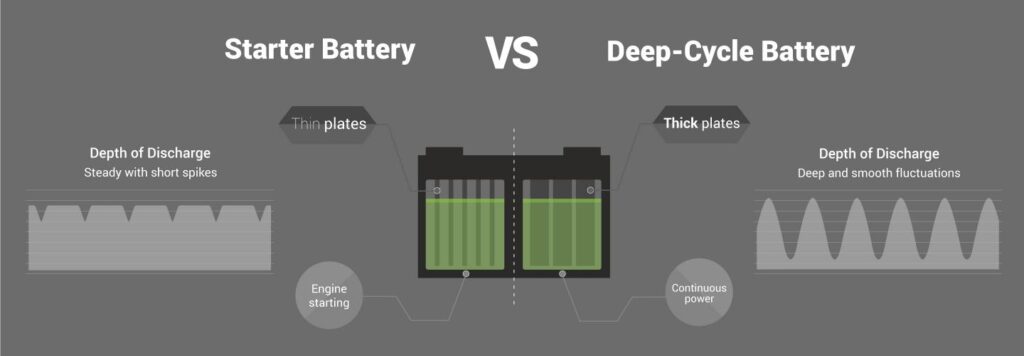Deep cycle batteries and ordinary lead-acid batteries, often referred to as starting batteries, differ in their design, construction, and purpose. Each type is optimized for specific applications and usage patterns.
1. Design and Plate Thickness:
- Deep Cycle Batteries:
- Designed with thicker lead plates to withstand repeated deep discharges.
- Thicker plates provide more material for chemical reactions during charge and discharge cycles.
- Ordinary Lead-Acid (Starting) Batteries:
- Have thinner plates designed to deliver high bursts of energy for short periods (e.g., engine starting).
- Not designed for deep cycling and may experience quicker degradation if subjected to frequent deep discharges.
2. Usage Patterns:
- Deep Cycle Batteries:
- Intended for applications where the battery is regularly discharged to a significant depth before being recharged.
- Designed for sustained, long-term power delivery over a discharge cycle.
- Ordinary Lead-Acid (Starting) Batteries:
- Designed for short bursts of high power to start an engine.
- Not intended for deep discharges; prolonged deep cycling can lead to reduced lifespan and performance.
3. Cycle Life:
- Deep Cycle Batteries:
- Typically offer a longer cycle life, meaning they can endure more charge and discharge cycles before experiencing significant capacity loss.
- Suitable for applications that require frequent cycling.
- Ordinary Lead-Acid (Starting) Batteries:
- Have a shorter cycle life and may suffer from capacity loss if subjected to deep cycling.
4. Capacity Ratings:
- Deep Cycle Batteries:
- Rated in ampere-hours (Ah) to indicate the amount of energy they can store and deliver over time.
- Available in various capacities to meet different energy storage needs.
- Ordinary Lead-Acid (Starting) Batteries:
- Also rated in Ah but optimized for high cranking power (Cold Cranking Amps – CCA) to start engines quickly.
5. Construction:
- Deep Cycle Batteries:
- Often available in various designs, including flooded (wet cell), sealed AGM (Absorbent Glass Mat), and gel batteries.
- Ordinary Lead-Acid (Starting) Batteries:
- Primarily available as flooded (wet cell) batteries.
6. Applications:
- Deep Cycle Batteries:
- Used in applications with sustained power needs, such as RVs, marine vessels, golf carts, renewable energy systems, and backup power systems.
- Ordinary Lead-Acid (Starting) Batteries:
- Used primarily for starting internal combustion engines in vehicles, such as cars, trucks, motorcycles, and small boats.
7. Maintenance:
- Deep Cycle Batteries:
- Maintenance requirements vary by type (flooded, AGM, gel), with some requiring periodic checking and topping off of electrolyte levels.
- Ordinary Lead-Acid (Starting) Batteries:
- Typically require less maintenance but may still need occasional electrolyte checks.
It’s crucial to choose the right type of battery based on the specific requirements of the application. Using a deep cycle battery in a starting application or vice versa may lead to suboptimal performance and reduced lifespan.


